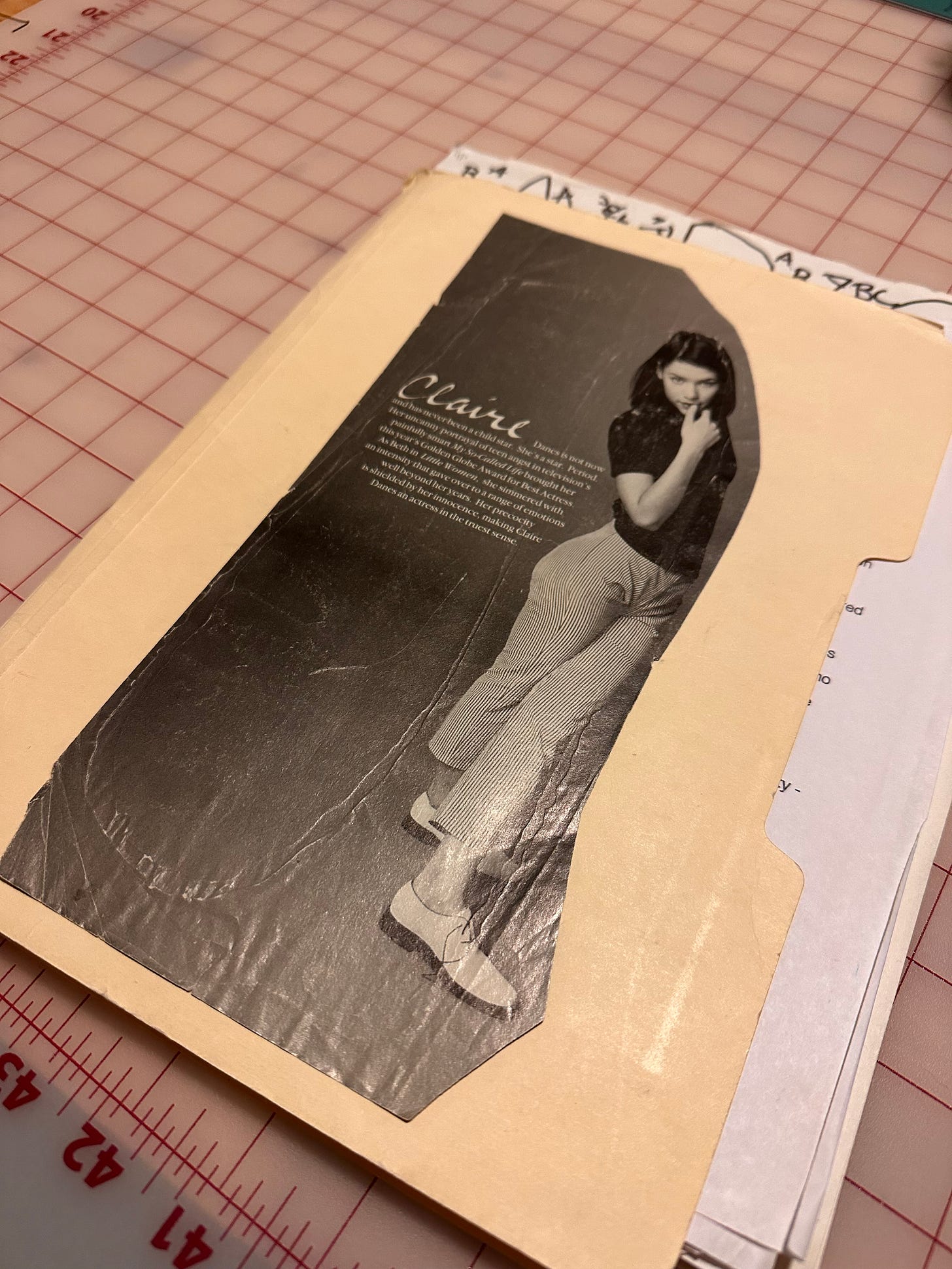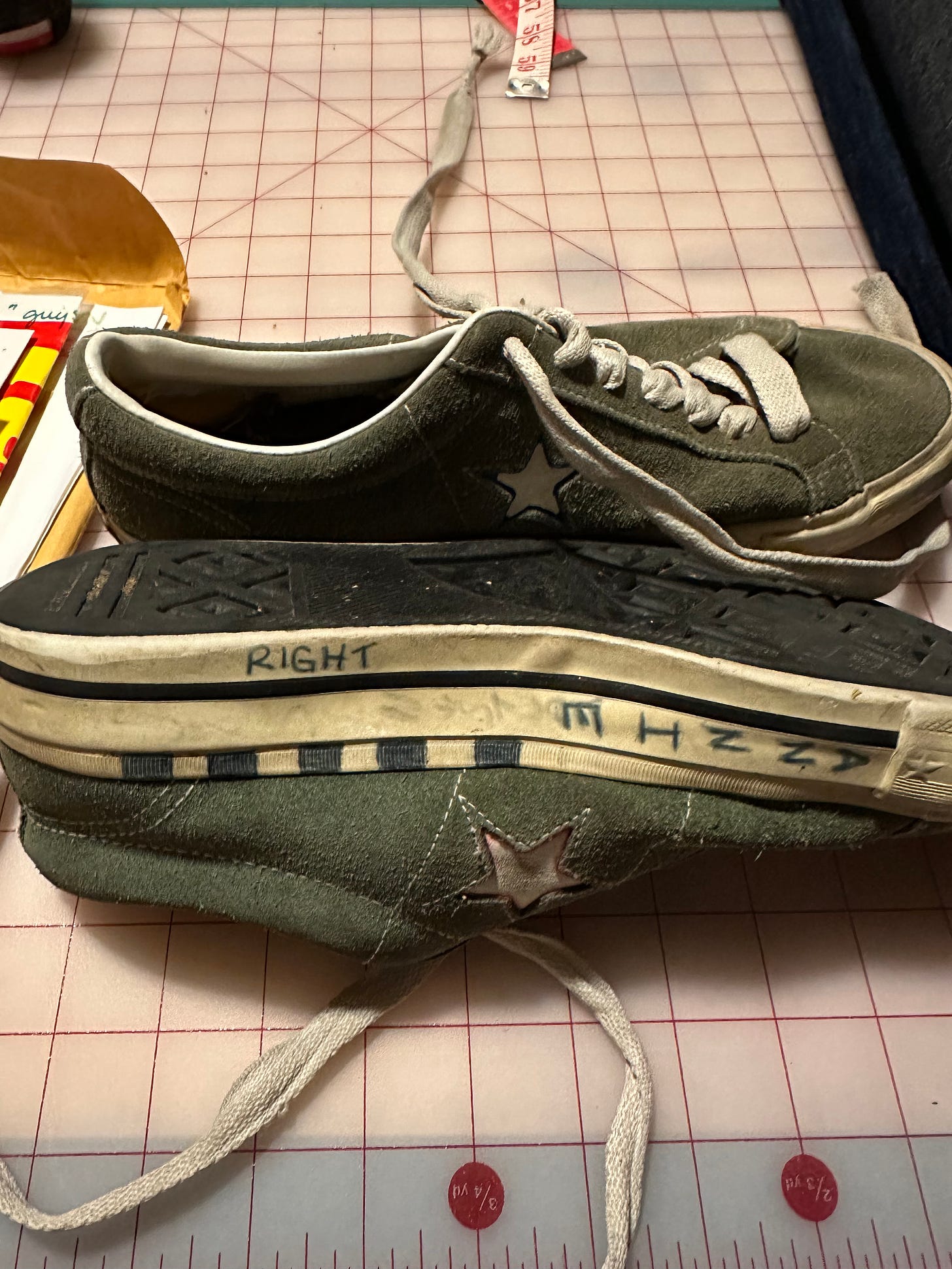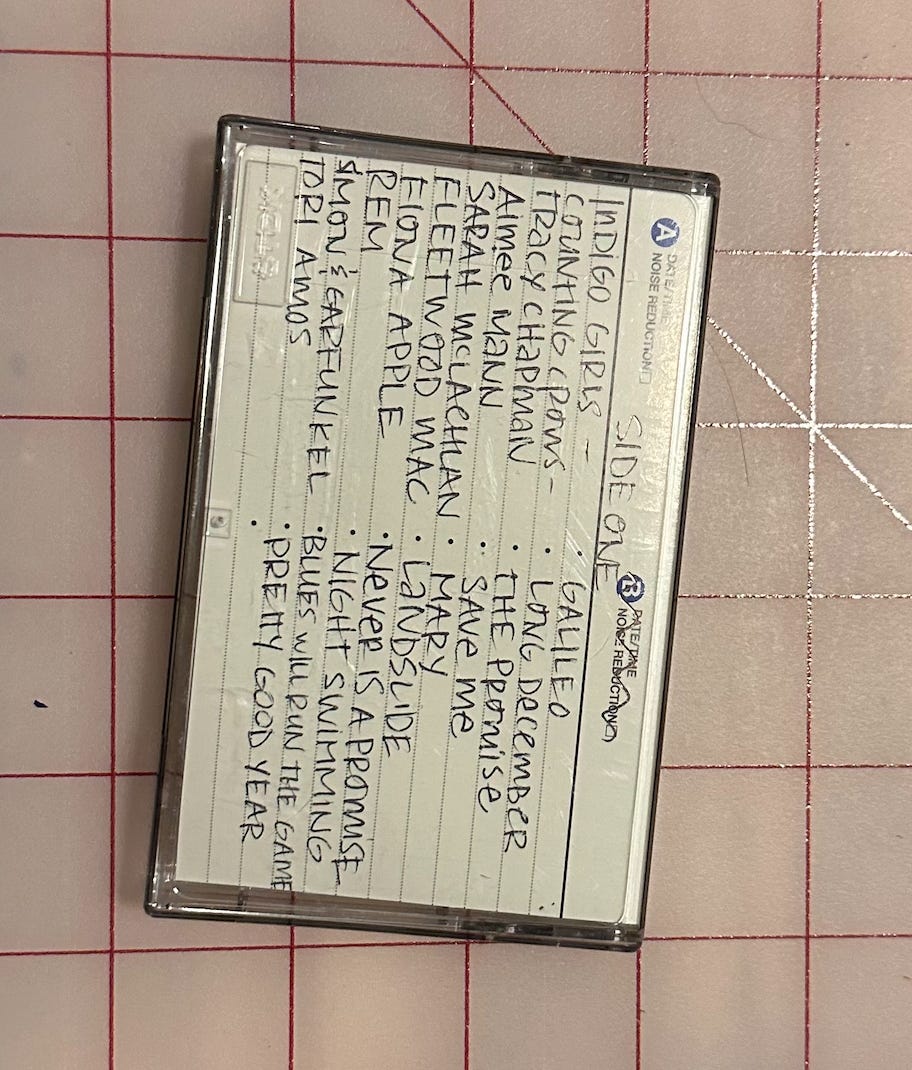Have you been meaning to subscribe and keep telling yourself you’ll do it the next time you’re at your computer or near your wallet or or or….I get it, I absolutely get it. But if you have the means, consider paying for the things that have become important to you. (If you don’t have the means, as always, you can just email me and I’ll comp you, no questions asked). Subscriptions make work like this possible.
My mom has moved several times, all within the same town, since I was in high school. Each time, I gave her the same instructions for the dozen overflowing shoeboxes in my closet: don’t you dare look inside them, but don’t you dare get rid of them.
In the last move, around a decade ago, the structural integrity of some of those boxes had begun to fail, and my mom violated the first rule (she looked inside them) to keep the second rule (actually keep them). Apart from my carefully preserved dance corsages, which were allowed to stay in their shoebox home, the rest were transferred to big manila envelopes and squashed in a big plastic bin.
That big plastic storage bin was allowed to sit undisturbed because my mom lives in a small town in Idaho with a basement approximately the size of my current house — as is the Idaho way. But now she is moving to a place with NO BASEMENT, and some tough decisions have to be made. By me.
I spent the day after Christmas pouring out the contents of these envelopes, taking pictures with my camera and, as an old friend of mine used to say, with my heart, and allowing that heart to be towed in so many unanticipated directions. Because turns out: I was an excellent archivist of my teen self.
The corsages, sure, but that’s classic memory book stuff. I’m talking about movie stubs and campaign pins, about 9th grade English notebooks and printed-out (and pencil-edited) drafts of college admissions essays.
I’m talking about a folder of random assignments I kept just because I really liked the photo of Claire Danes that I tore from a magazine and affixed with Elmer’s Glue.
I AM TALKING ABOUT A PAIR OF CONVERSE ONE STARS I KEPT SIMPLY BECAUSE THEY WERE THE FIRST SHOE MY TEENAGE SELF DEEPLY LOVED, not because I ever planned on wearing them again.
I also kept:
Every letter ever sent to me at camp (I went to a lot of camps, most of them the very cheap kind where your bunkhouse has squirrels) which was significant because I gave every person I knew my address and INSISTED they write me
Every folded note I received from 7th through 11th grade, which, in hindsight, was the era of peak folded note passing, right before phones took over teen communication….most of these notes begin with “Whatssup, I’m just here in Social Studies.”
Every wallet-sized sports and dance and senior photo ever given to me, and there were a lot because we had five dances a year
A 5 x 7 glamour shot (like, full mall glamour shot) of my 10th grade best friend with her mom and sisters
A note from said 10th grade best friend in which she talks about how she’s supposed to be taking a test but has only read five pages of the book and is instead writing me a note about our after-school plans (pick up her sister, go to the pool) and “this sort of reminds us of our friendship, because you’re always thinking of school and I’m always looking for something fun to do. Hey do you want to go to Arby’s for lunch, or Sharp’s Burger Ranch? You choose. Maybe we can stop by the mall today.”)
A bunch of bad free verse poetry written in ~cool~ handwriting
Dozens of plastic folders of photo negatives, some marked to take to the developer to get REPRINTS
The lyrics from about 40 different songs that I strategically cut out of the liner notes and COLLAGED
The ribbon for being voted “Most Likely to Succeed” in the 9th Grade Freshman Elite Voting (spelled ELETE on the ribbon; the real prize was “Best Looking,” which went to someone named NICKI)
A packet of letters from my Granddad, written on his word processor (or early computer) and printed on his personal stationery, with lines like “I’ve always tried to tell you kids how nice Minnesota is, but I can’t say anything very good about it today” (9/18/91) and “I’m glad you liked the sweater but I’m now on the mailing list for J.Crew; I’m afraid I’m not much of a prospect for them” (1/14/96)
My first cassette tape (New Kids on the Block, Hangin’ Tough) plus several mixtapes still in their carriers + playlists, the most perfect of which is captured below
None of these findings are unique; in fact, when I posted some of them to Instagram (along with the full extended folder of my senior pictures, featuring no less than five outfit changes) several people DMed to ask: are we the same person? Of course not. But there were a whole lot of teens from that era whose artifacts, saved or forever lost, would be similar. We were navigating the line between popularity and individuality, figuring out how to fit in while also figuring out what we actually liked.
The movie stubs, the VHS tapes, the liner notes, the mix tapes — they were the backdrop, the structuring forces, the songs that gave actual words to feelings I couldn’t articulate myself. I didn’t find it in the archive, but I remember typing up Mariah Carey’s “Looking In” (the finale on her 1994 album Daydream) in 9th grade English, printing it out in cool font, and then passing it off to friends as my own poetry. (Choice lyric: “Don’t believe/That’s all there is to see/You’ll never know the real me.”)
I mean, blatant plagiarism, but also: I was trying to say something! Just like I was trying to say something (to a boy) with that mixtape playlist — something about my musical taste, sure, but I was ultimately much more concerned with communicating bittersweet longing.
All archives are, to some extent, narratives: edited stories of the self or others. What I kept then was a story of myself that felt precious and still, at that point, untold. I wasn’t saving in the hopes of someone else discovering who I was. I think it was much more a case of ensuring my future self’s attention. The artifacts were the grammar that made the story readable.
And it’s true: going through that archive, that teen story re-emerged, in all its melodrama. I felt alone and cultivated complicated, engrossing friendships that somehow always disappointed me. I coveted perfection and praise and couldn’t understand how it made others resent me. There’s no video footage of me staring at the wall and yearning but it’s palpable in that track list, or even in the mention — in one of the letters sent my way — of the five-page letter I’d sent first.
When I went through the piles, I was editing the archive again. I kept the photos from the one high school dance where I felt pretty and effortless; threw the ones that reminded me of the desperation and fear of waiting for someone, but the right someone, to ask you to the dance, and just how deeply unfun they were, beneath that performance of having the most fun night of your teen life.
I opened random notes, skimmed them, found little — but was amazed by that nugget of insight from my 10th grade best friend, that precise read of our friendship and what would ultimately end it, casually tucked in before the question of whether to go to Arby’s for lunch. I kept her note but tossed the glamour shot 5 x 7 of her family, who I’d loved as my own in a season of my life when my own family was unstable, but mostly loved because the mom was a cool mom and their house was the house everyone went to on a Friday night.
I found myself clinging to the early artifacts of college: the hilarious list I made with the pros and cons of where to go (underlined three times under the place I eventually went: “TOTAL FRESH START”); the letter (not email!) from the college introducing me to my freshman roommate, plus her introductory letter (not email!) to me; a random inside joke drawing one of my first real college friends made for my dorm room door; the emails from that first year I printed out because I still thought that the best, most precious things needed to be in physical form.
My teen years are so much more vivid to me than my late 20s or 30s, which passed with so little physical trace. My Gmail goes back to 2005, but an email — even the long, witty sort we used to write back in those days — has no envelope, no handwriting, no address to remind you exactly where you were when you received it. The burned CDs, the DVDs, most of my early digital photos — they’re lost to obsolescence and too many moves.
In my mom’s basement, I found all of my college papers, complete with professor feedback. My undergraduate thesis still lives on in (mortifying) bound form in the college library. But the work I’ve done since could disappear, already has disappeared, so quietly. My dissertation is locked in a gated database, but my first blog (which a handful of you read) is gone; the 8000-word Scandals of Classic Hollywood I wrote for The Hairpin (which many more of you read) are propped up on a rickety site that could disappear at any moment.
Several years ago, BuzzFeed unceremoniously removed photos and formatting from thousands of articles in an attempt to avoid dealing with copyright infringement, even on pieces with original, fully licensed photography and design. Today, those pieces look like they could be part of Ask.Com — and who knows where they’ll be in five years. This newsletter arrives in thousands of inboxes every week and somehow feels less solid than a note I wrote on graph paper in 8th grade Algebra. Our tweets, our text messages, our Slacks, our Discord, our Instagram Stories, our Facebook posts, our Livejournal entries — they are us, and they are not ours. They might be part of a data archive of “us” that advertisers buy and sell, but apart from the most scrupulous downloaders and PDF-makers and organizers, they will not be part of our story.
I want to trust that this generation of teens will figure out a new way to archive themselves. But their online practices trend toward brutal, relentless self-editing — or the sort of hyper-documentation that creates an unnavigatable sea of content, all the easier to mass delete. It makes sense: the traces of their infancies and childhood are likely locked on some old computer, living in a cloud no one visits, or lost to a faulty phone back-up. They learned that capturing everything can also mean capturing nothing. They’ve also learned that self-documenting online is signing yourself up for some sort of future liability or embarrassment: ultimate cringe. Tracelessness becomes aspirational.
And yet: there’s resurgent demand for cassettes, CDs in the jewel case, flip phones, disposable cameras. I love it, of course, the way any generation should love watching a new one revel in its past delights. Even if the motive is largely aesthetic, the medium still changes the message: there’s so much to be said for revisiting and refocusing the way you encounter the world and the art in it. But what I hope, particularly amidst adults’ incessant push to consume and then ruthlessly declutter, is that they make and keep things, too.
We are so much more than what we keep. But what we keep anchors us when and where memory inevitably fails. You don’t need a mom’s basement to put aside the things that make you feel like you — to begin or continue to preserve the language that future you will one day read. The storage container didn’t magically contain everything I felt or made or endured as a teen, not even close.
But even in its whittled-down version, it feels abundant, even luxurious, in its capture of that burgeoning self. What I put in those shoeboxes in the ‘90s — that was a message in a bottle, undirected and earnest and flailing. The box I keep now — it’s a love letter to the person I know better than any other. It’s past time, I realize now, to start a new one.
This Week’s Things I Read and Loved + The Good Stuff From this Week:








